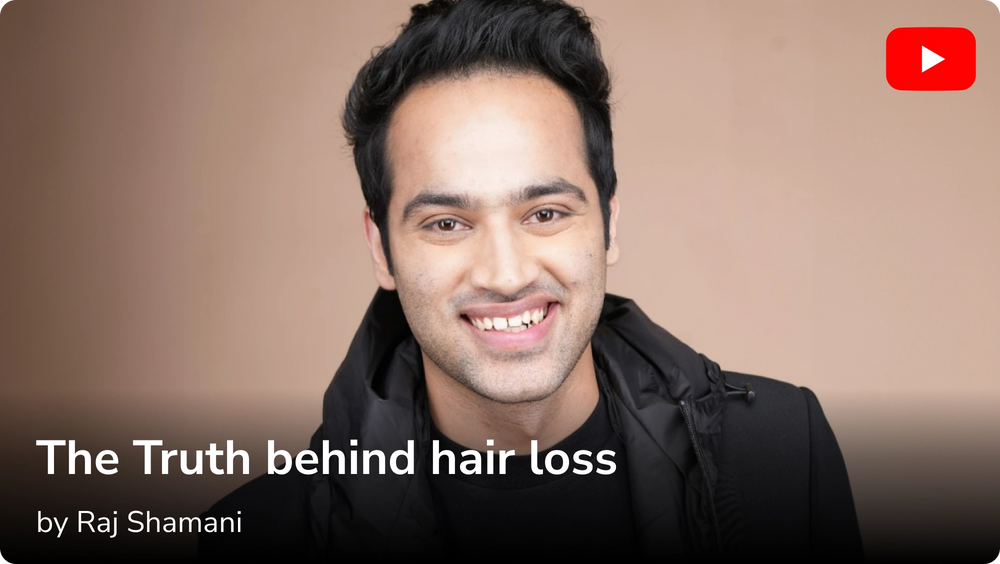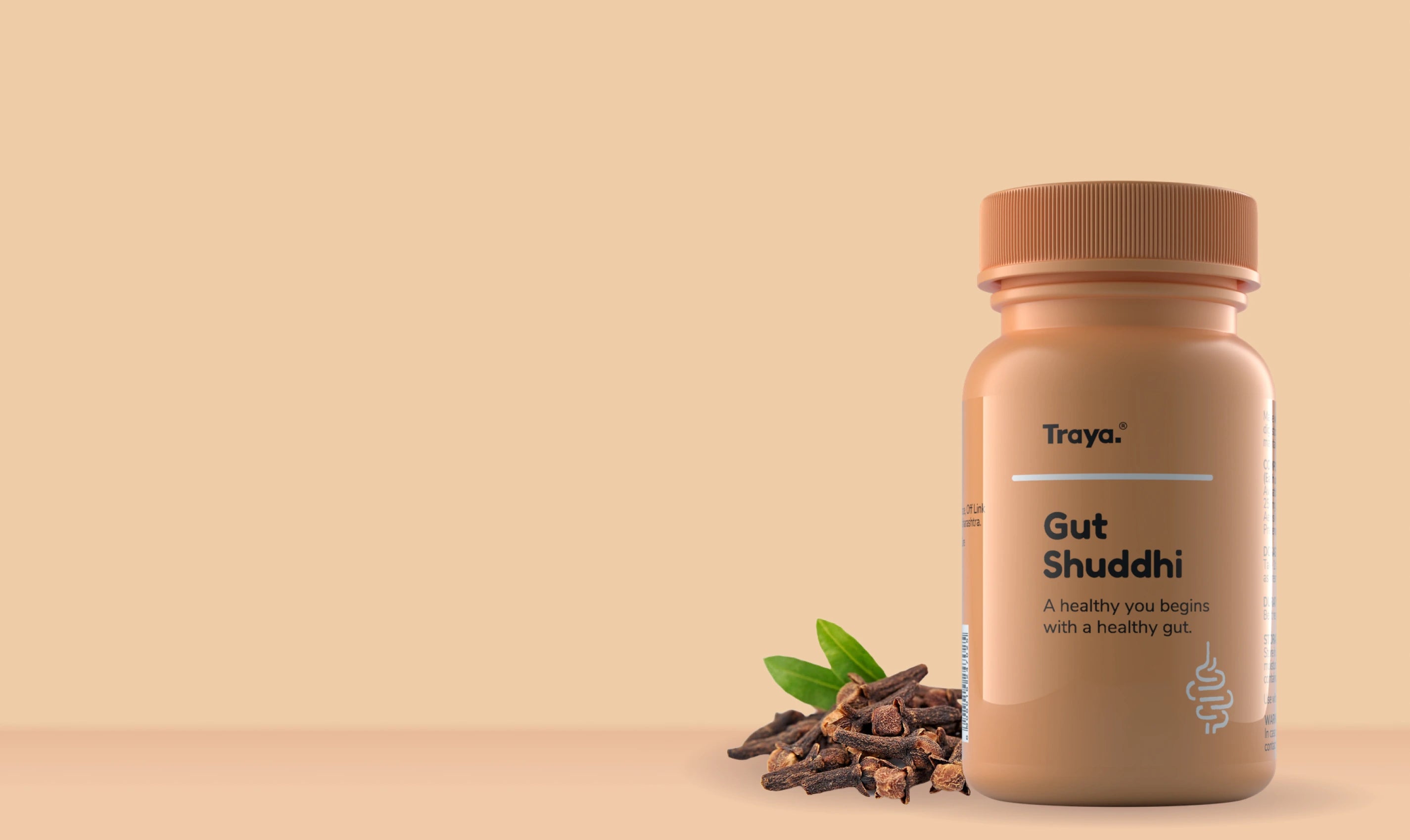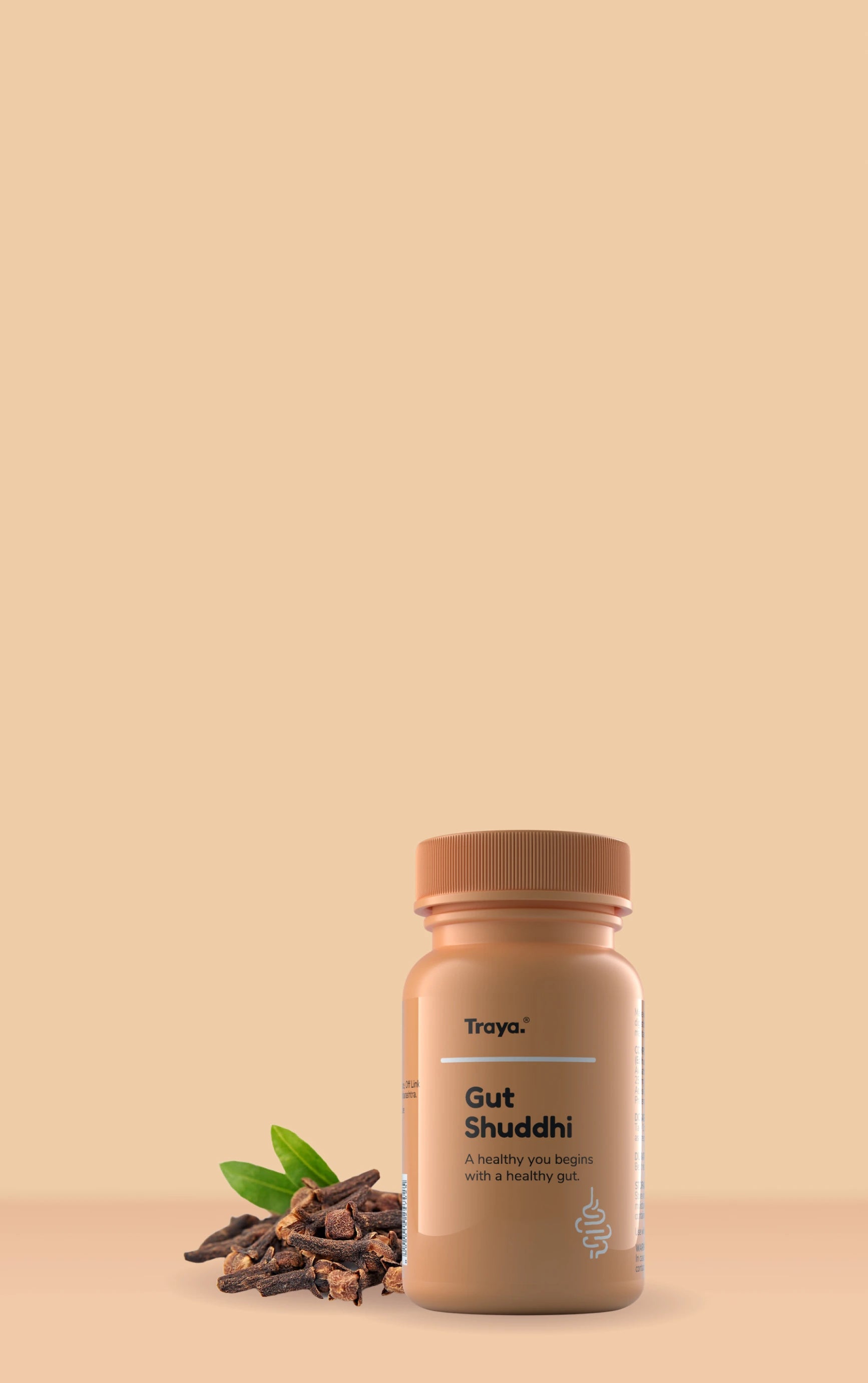Let's tackle our hair struggles together.
Hair Fall Queries?
Join our community to get answers to all your hair queries by certified hair coaches.
JOIN THE GROUPPlease download Telegram to become part of our community
Your cart(0)
Your cart is currently empty.
Your cart(0)

Air, water and the kind of food we eat, all of it impacts hair.
High stress levels can disrupt the hair cycle, leading to excess hair fall
Natural body imbalances can lead to thinning and increased hair fall
When your body isn’t functioning at its best, hair can become dry, weak, and prone to breakage
A diet lacking essential nutrients can slow down hair growth
TRAYA’S HOLISTIC PLAN FOR HAIR FALL
Our approach combines the goodness of three sciences. With ingredients from the most authentic sources, we personalize your solutions delivering assured results.
Take The Hair TestJoin us to break the hair loss myths and get the right information out.





Let's tackle our hair struggles together.
Please download Telegram to become part of our community


TRAYA 2X2 REGIMEN
Google Reviews
You’ve just experienced one of the most powerful transformations a body can experience pregnancy and childbirth. While you may have expected the sleepless nights, the feeding schedules, and the emotional waves, one thing that often completely catches women off guard is hair loss.
Sometimes it’s a slow trickle.
Other times, it feels sudden, like clumps of hair showing up in your comb, on the pillow, or down the shower drain.
And in that quiet moment, standing in front of the mirror, it’s not just the hair you’re looking at. It’s the worry.
“Is this normal?”
“Is something wrong with me?”
“Will it ever grow back?”
If you’ve had any of those thoughts, you’re not alone and more importantly, you’re not doing anything wrong.
Postpartum hair loss is extremely common.
In fact, nearly 60% of women experience noticeable hair shedding in the months after delivery. And yet, almost no one talks about it until it begins.
That silence is what makes it more challenging. Because without answers, every falling strand feels like a reason to panic.
But here’s the good news most postpartum hair fall is temporary, expected, and manageable.
There’s a natural rhythm to it, rooted in the hormonal changes your body is going through.
That said, not all hair fall is harmless. Sometimes it lingers longer than it should. Sometimes it’s more severe than expected. And that’s when it’s essential to understand what’s normal and what needs action.
This guide will help you:
Understand why postpartum hair fall happens
Learn how long it usually lasts
Spot the signs that suggest your hair needs help
And know what to do next calmly, clearly, and without confusion
Because you’ve already done the hard part. Now it’s time to give your body and your hair the care it deserves
What Exactly is Postpartum Hair Loss?
Let’s start with a simple truth:
You’re not “losing” your hair. You’re just letting go of hair your body held onto a little longer than usual.
During pregnancy, a hormone called estrogen increases significantly. It doesn’t just help support the baby it also slows down your normal hair-shedding cycle. That’s why so many women say their hair felt thicker, shinier, and fuller during those nine months.
But after delivery, that hormone level drops and fast.
And as your body recalibrates, all the hair it was holding back starts to shed.
Doctors call this Telogen Efflux, a temporary shift in your hair cycle in which a large number of strands enter the resting (or shedding) phase all at once.
It usually begins about 6 to 8 weeks after delivery and can last anywhere from 3 to 6 months. Some women barely notice it, while others feel like it’s all they can see in the mirror.
And because it doesn’t always start immediately after childbirth, most new mothers don’t realise what’s happening. They often think:
Is this from breastfeeding?
Is something wrong with my scalp?
Is this permanent?
The answer, in most cases, is no.
Postpartum hair loss is a natural, temporary response to the changes your body is going through, not just hormonally but physically and emotionally.
That said, it doesn’t mean you should ignore it entirely.Some women experience more severe or longer-lasting shedding; in those cases, your body might try to say something more.
First, let’s reassure you: postpartum hair fall is normal.
In the weeks after childbirth, most women will start to see more hair fall than usual.
It may begin around 6 to 8 weeks after delivery, and can continue for a few months. In most cases, it peaks by the third or fourth month and starts to ease off by the sixth.
You might notice:
More strands on your pillow
Hair gathering in the drain
A thinner ponytail
Or even a widening parting
It can feel alarming, especially if your pregnancy hair was thick and strong.
But remember, this isn’t permanent. It’s your body adjusting.
So, when is it not something to ignore?
Here are a few signs your body might need extra attention:
Hair fall hasn’t reduced even after 6 months postpartum
You’re seeing noticeable thinning or scalp visibility, especially around the crown or temples
There’s hair fall along with fatigue, irritability, or unusually low energy levels
You’ve had complications post-delivery, like heavy bleeding, poor recovery, or digestive issues
You feel like the shedding has gotten worse, not better, over time
One more subtle sign?
You’re not just seeing hair fall you’re starting to feel anxious about it regularly, affecting your confidence.
That’s not a vanity issue. It’s a health signal.
Hair is one of the first things your body stops doing when it’s under pressure physically, emotionally, or nutritionally.
So if your hair isn’t bouncing back, it may be because your system is still catching up.
And that’s okay. It just means you need a bit of support, not fear, not overreaction, and definitely not silence.
You might’ve heard friends say,
"My hair fell out for a few weeks, then it returned to normal."
But for you, the shedding hasn’t stopped. Or it’s been so heavy that it’s hard to ignore.
That doesn’t mean something’s wrong with you. It just means your body’s recovery path might look different, and that’s worth understanding.
Here’s what we’ve seen in women who experience more intense or longer-lasting postpartum hair fall:
Pregnancy and childbirth use many of your body’s nutrient reserves especially iron, zinc, B12, Vitamin D, and protein.
If your diet was inconsistent during pregnancy, or you lost a lot of blood during delivery, or you’ve been skipping meals postpartum (which is very common while managing a newborn), your body might be low on the raw materials needed for regrowth.
Hair is one of the first things your body sacrifices when nutrients are in short supply.
It’s no secret that the postpartum period is exhausting. Interrupted sleep, unpredictable feeding schedules, and physical recovery can stretch for weeks or months.
But when sleep is chronically deprived, the body stays semi-stressed. This can disrupt hormonal balance, slow healing, and push more hair into the resting/shedding phase.
Even two hours of uninterrupted rest can make a difference, so sleep quality matters more than just hours slept.
After delivery, your estrogen levels drop that part is expected.
But in some women, additional imbalances creep in:
Thyroid dysfunction (common in postpartum months)
PCOS symptoms resurfacing
Or irregular cycles while breastfeeding
These changes can delay recovery or create overlapping causes of hair loss. Without bloodwork or a proper health mapping, they often go unnoticed.
Even if you're not feeling mentally “stressed,” your body may still be under pressure.
The physical strain of birth, adjusting to new routines, body image changes, breastfeeding challenges, and the invisible mental load of caring for a newborn all of this contributes to a state of low-grade, chronic stress.
And stress is a known trigger for Telogen Effluvium.
In fact, it can extend the shedding cycle if the body doesn’t feel safe enough to resume growth.
This doesn’t mean you need to meditate for hours. It means you need support, small systems that help your nervous system breathe again.
Some women may already have underlying hair concerns that pregnancy temporarily masks, like:
Early signs of female pattern hair thinning
Naturally low hair density
Or sensitivity to DHT (a hormone that contributes to genetic hair loss)
When the hormonal “protection” of pregnancy lifts, these pre-existing tendencies may surface more strongly.
This is where proper diagnosis matters. Because not all postpartum hair fall is just about the baby sometimes, it’s also about your body’s unique baseline.
So if your hair fall feels different heavier, longer, more visible it's not just in your head.
It's your body asking for help in quieter ways.
And the earlier you understand those signals, the easier it is to support recovery, without panic, without guesswork, and without wasting time on treatments that don’t match your real cause.
Hair fall after delivery can feel sudden, but recovery, like most postpartum, is gradual.
The key isn’t to do everything at once. It’s to understand what your body needs at each stage of recovery and consistently support it.
Let’s break that down.
In the early weeks of hair loss, the instinct is to panic, switch products, try DIY remedies, over-oil, or buy every shampoo with "anti-hair fall" on the label.
But in reality, this is the stage when your body is still recalibrating, your hormones are settling, and your sleep is still unpredictable. Your system needs stability, not stimulation.
What helps here is simplifying:
Use a mild, fragrance-free shampoo, not an aggressive “treatment” one
Avoid heat styling, tight buns, or anything that adds tension to already fragile strands
Don’t brush your hair more than needed
Begin a gentle scalp massage routine 2–3 times a week even 5 minutes can help relax tension and boost blood flow
This isn’t about regrowth yet. It’s about not making the shedding worse.
By now, usually around 2 to 3 months postpartum, your hair cycle begins to shift again. This is where the fundamental foundation for regrowth is built. But that growth depends on what your body has available.
For many new mothers, that means this stage requires nutrient replenishment.
Here’s what we focus on clinically:
Iron Low iron is one of the most common, overlooked causes of postpartum hair thinning (especially after blood loss in delivery)
Protein Essential for keratin production, and often reduced due to poor appetite or irregular meals
Vitamin D and B12 Both support the health of hair follicles and the scalp environment
Zinc and Omega-3s Critical for scalp healing and strand strength
This isn’t about random supplements. It’s about restoring what pregnancy, childbirth, and breastfeeding may have depleted gently and consistently.
Equally important is hydration. Many women unconsciously reduce their water intake postpartum, but every cell, including hair follicles, relies on it.
At this stage somewhere between 3 to 6 months postpartum most women see their hair fall slow down. But for some, regrowth doesn’t feel noticeable.
That’s where additional support may help:
Scalp health becomes important buildup, itching, or excess oil can block growth
Mild exfoliation once a week (with a safe scalp scrub or a few drops of diluted salicylic acid) helps clear residue
Targeted topical actives like peptides, Redensyl, or caffeine-based serums (safe for lactating mothers) can encourage dormant follicles to re-enter the growth phase
Sleep still matters. A few nights of interrupted rest won’t reverse progress, but consistent poor sleep can delay regrowth
Remember: regrowth doesn’t always mean new baby hairs overnight. It may appear first as reduced shedding, a fuller feel, or a denser hairline.
Jumping from one product to another every 2 weeks
Expecting hair masks or oils to fix internal deficiencies
Ignoring the emotional and physical stress of new motherhood
Treating it like a cosmetic issue when it’s a system-level event
Postpartum hair fall isn't just about hair it's about recovery. And once your system feels safe, steady, and supported, the regrowth usually follows.
Not all hair loss after childbirth needs a prescription. It usually begins gradually, peaks around the third or fourth month, and slows down. But when it doesn’t? That’s when it makes sense to check in not because it’s urgent, but because it’s worth understanding.
Here’s what we typically look for before suggesting a deeper assessment:
By this time, your estrogen should have settled, and the post-delivery shock to your hair cycle should have passed. If you’re still seeing visible shedding, thinning near the temples, or no signs of regrowth, something else may be at play and it’s better to investigate than wait.
Hair doesn’t fall in isolation. It’s often part of a broader pattern, especially when your system runs on reserve.
Common symptoms that raise concern:
Constant fatigue or brain fog
Mood changes that don’t feel like “just a lack of sleep”
Changes in appetite or digestion
Feeling cold all the time or experiencing sudden weight shifts
Irregular periods after delivery
These could indicate thyroid imbalance, iron deficiency, or postpartum hormonal shifts all reversible, but best caught early.
This matters more than most people admit.
For many new mothers, the shedding doesn’t just stay in the comb. It shows how they tie their hair, avoid photos, or feel about stepping outside.
And if it’s reached that point even if medically “everything looks normal” that’s reason enough to speak to someone.
Because hair recovery isn’t just physical, it’s emotional, too.
At Traya, for example, we don’t start with a product. We begin with a multi-science hair test that helps us understand:
Whether the hair fall is still within a standard postnatal window
If there are visible signs of follicle miniaturisation (early signs of pattern thinning)
What your nutritional status and medical history suggest
How stress, sleep, and lifestyle might be impacting your recovery
Whether you’d benefit from internal support, topical care, or just a plan to pace things out calmly
There’s no pressure to jump into treatment. But there’s value in knowing exactly where you stand, so you’re not stuck in a loop of guesswork or guilt.
Still unsure whether your hair fall is just part of the natural postpartum cycle, or something that needs a closer look?
Take a minute. Read through the following questions. No scoring. No overthinking.
Just observe what feels familiar.
Did your hair fall begin around 6–12 weeks after delivery?
Are you losing more hair than usual, but mostly evenly across your scalp?
Do you notice more strands while washing, combing, or on your pillow, but no patches or bald spots?
Have you been sleeping inconsistently, skipping meals, or feeling emotionally drained?
Are you currently breastfeeding or recovering from a complicated delivery?
Has it been over 5–6 months, and the shedding hasn’t slowed down yet?
Are you also experiencing signs of fatigue, low energy, brain fog, or mood swings?
Have your blood tests (if done) come back normal, but your hair fall continues?
If it’s just one or two, chances are you’re in the standard postpartum recovery window and your hair may just need time, rest, and steady care.
But if three or more of these ring true, especially the latter ones, it might be time to go beyond guesswork.
Because sometimes, what feels like “just stress” or “just postpartum” could be:
A lingering nutrient deficiency
An underlying thyroid shift
Or a scalp issue that’s been overlooked
None of these are permanent, but they respond better when caught early.
If you're in the thick of postpartum hair fall, it’s easy to feel like nothing is changing or that things are getting worse. But sometimes, progress is quieter than we expect.
Use this checklist to gently track your recovery and see where you need more support. No pressure. No timelines. Just clarity.
Hair fall has started to slow down even if it hasn’t stopped completely
You’re not noticing a visible scalp in new areas
Baby hairs are showing up along your hairline or parting
The texture of new growth feels soft but steady
Your ponytail might still feel thinner, but it’s no longer shrinking week to week
If these signs show up even subtly your body is on the right track.
Eating three balanced meals a day, with protein in at least two of them
Taking supplements only if prescribed not based on ads or social media advice
Getting at least one full hour of uninterrupted rest during the day or night (hard, but worth aiming for)
Washing your hair regularly (2–3 times a week) without fear buildup can worsen shedding
Avoiding tight hairstyles, aggressive brushing, or heat styling
Using only gentle shampoo and minimal hair products
Checking in with yourself emotionally are you carrying more than you admit?
This isn’t a test. It’s a temperature check for your hair, health, and recovery timeline.
If a few of these are missing, that’s not a reason to feel behind. It’s simply a sign that your body might need a little more attention and that you deserve to give it that care.
Q1. How long does postpartum hair loss usually last?
Shedding usually begins 6–12 weeks after delivery and slows down by 5 to 6 months. Some women may see hair fall stretch up to 9 months, especially if stress, lack of sleep, or nutritional gaps continue. But the peak shedding usually doesn’t last forever.
Q2. Will my hair go back to how it was before pregnancy?
In many cases, yes, though it may take time. That said, some women notice small long-term changes in hair texture or volume, especially if they had a C-section, significant blood loss, or underlying hormonal issues like thyroid imbalance or PCOS. The goal is regrowth and density, not always returning to the exact pre-pregnancy look.
Q3. Can I oil my hair or use home remedies during this time?
You can but think of it as scalp care, not a cure. Oiling may help improve blood flow and relax tension, especially if done gently. But it won’t stop the internal shedding process triggered by hormones or nutrient dips. Use what feels good, but don’t expect it to replace recovery from the inside.
Q4. Is it safe to use hair serums or treatments while breastfeeding?
It depends on the ingredients. Most topical products with mild actives like peptides, caffeine, or botanical extracts are safe. Avoid harsh chemicals or potent formulations unless approved by a dermatologist. When in doubt, keep things simple until your baby is weaned or your doctor gives a go-ahead.
Q5. Should I get blood tests done if my hair fall hasn’t stopped?
Yes especially if you’re crossing the 6-month mark with continued shedding or no signs of regrowth. A basic postpartum panel can check for:
Iron levels
Vitamin D and B12
Thyroid function (TSH, T3, T4)
Inflammation markers
These tests can often explain what your mirror can’t.
Q6. What’s the best shampoo or product for postpartum hair fall?
There’s no “best” product that’s the truth. Use a gentle, fragrance-free shampoo without sulfates or parabens. Avoid anything that promises instant regrowth. Your scalp needs to stay clean, irritation-free, and balanced that matters more than any label.
Q7. Is something wrong with me if my hair falls worse than others?
No.
Every woman’s body heals differently. Some recover faster, some take longer. Some had nutrient-rich pregnancies, others faced complications or stress. None of this is a reflection of your strength only of your biology. And biology is never one-size-fits-all.
This brings us to the end of your guide.
If you've been nodding to some of these questions or if you're feeling seen for the first time that’s your sign to stop blaming yourself and give your body what it truly needs: rest, repair, and attention.
The claims and results mentioned are based on multiple internal studies and customer research surveys that Traya has conducted with a statistically significant sample size of users who were under expert observation and guidance
93% saw results*
Traya conducted an internal study over both men and females facing hair fall and 93% saw results* after using the complete Traya solutions consistently for a period of 5 months. This study was conducted in December 2022.
Money back Guarantee
Traya’s 100% money back guarantee is valid only if you have been regular with the complete Customised plan for all consecutive months of your recommended period. Each customised hair kit is valid for only 30 days. If any individual has not seen any regrowth or control in hair fall, you can ask for a refund. However, once you apply for the money back guarantee, the team would then do a thorough check on consumer regularity based on every order date and then assign a qualified hair experts to determine eligibility . An exception to this policy is for those customers undergoing serious health conditions.
Traya’s Holistic 3 Science Formula
Traya’s 3 Science Formula is a synergistic mix of Ayurveda, modern science & Food Science designed specifically to cater to hair loss conditions stemming from multiple root causes. With lab tested ingredients and adaptogenic herbs, Traya’s Science-Backed formula clears internal blockages and boosts hair regeneration naturally. When blended with a healing dietary plan, it delivers great results in attaining long-term hair growth.
Traya Free hair test (™)
Traya’s Hair Dx test is powered by a proprietary algorithm to examine a user's hair & wellness profile. With the help of a distinctive image-capturing technique & experts- formulated examination, it is able to precisely analyze the type, stage & root causes of a certain hair loss condition.
8 lakh+ customers
Traya Free hair test (™) has been taken by more than 8 Lakh+ Customers - Data acquired from Traya customers.
Ayush Certified - Digest Boost, Cholest Vati and Consti Clear are Ayush Certified Products.
Traya’s Ayurvedic Products are based on natural and Ayurvedic formulations. These are completely safe for human use, but it is possible that certain ingredients may cause allergic reactions to some individuals.
Accurate hair diagnosis
The Traya free hair test (™) is a proprietary algorithm developed with the help of our in-house hair experts that provides Accurate hair and health diagnosis, provided you mention all the correct details about yourself. It gives a precise diagnosis about the type, stage and root cause of a specific hair fall condition.
Long Lasting Visible Hair Results
Traya’s complete "plan" gives visible and long-lasting results provided you’re on Traya’s hair maintenance kit. Since Traya works on the internal root causes of hair fall and hence our customers have seen long lasting results
Trusted by 70+ Hair Experts
Traya has been tried and loved by over 70 hair experts all over India to maintain healthy hair growth.
Award Winning Trusted Brand
India’s Healthcare Excellence initiated by Brands Impact has awarded Traya as the Most Effective Haircare Product of the Year 2022
Traya Women Santulan (™)
Traya’s Women Santulan is a unique technology that uses a combination of herbs treated in a specific manner (kalpa) to meet the bio-specific needs of women going through different stages of life. Santulan is a supplementary range to Traya’s 3 Science Formula which balances and nourishes the body inside-out delivering long-lasting hair growth results and overall health.
Hair Growth Plan starts at Rs 1699 pm* - The price mentioned is for a male of age 23 with stage 1 type hair fall based on the results of the hair test taken on the website. Prices may vary for individual customers depending on the results of the hair test and internal root causes
Hair Growth Plan starts at Rs 2000 pm* - The price mentioned is for a male of age 25 with stage 1 type hair fall based on the results of the hair test taken on the website. Prices may vary for individual customers depending on the results of the hair test and internal root causes